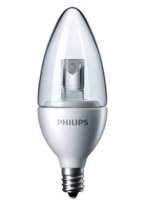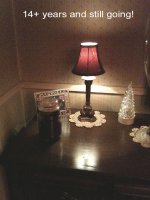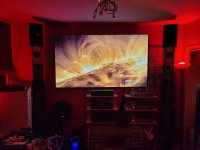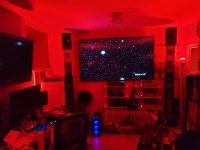They changes from fluorescent to LED in my building. Most are working fine - maybue 2% failed within a month of install. Dud or crap design?
Same with a brand new condo they built. The light for the parking sign was flickering within a week. Another dud? It's been fine since they changed it.
My building could replace the halogen MR16 in the elevator with LED... They burn out at least once a month and there are only 12 of them. For 60$ they could sort it. Ultra Bright GU10 MR16 E27 E14 Dimmable 12W 9W 6W COB LED Spotlight Bulbs Bright | eBay
Same with a brand new condo they built. The light for the parking sign was flickering within a week. Another dud? It's been fine since they changed it.
My building could replace the halogen MR16 in the elevator with LED... They burn out at least once a month and there are only 12 of them. For 60$ they could sort it. Ultra Bright GU10 MR16 E27 E14 Dimmable 12W 9W 6W COB LED Spotlight Bulbs Bright | eBay
Halogen is famous for living short.
LED must be seen in the large numbers like 1000 in a store all working 12 hours a day or more. There the failures happen and reliable numbers can be seen. I have 1 (one) that also lives very long but that maybe doesn't apply to his brothers and sisters used elsewhere. Statistics...
LED must be seen in the large numbers like 1000 in a store all working 12 hours a day or more. There the failures happen and reliable numbers can be seen. I have 1 (one) that also lives very long but that maybe doesn't apply to his brothers and sisters used elsewhere. Statistics...
Last edited:
I've had this Philips LED 3.5W (10 watt equiv) bulb burning CONSTANTLY in a small lamp since 2007, and it's STILL going strong.
I never turn the lamp off, it's a nice "night light" in the dining room, so I don't stub my toe going for late night snacks in the kitchen.
That about 125 THOUSAND hours.... 14 years!
I never turn the lamp off, it's a nice "night light" in the dining room, so I don't stub my toe going for late night snacks in the kitchen.
That about 125 THOUSAND hours.... 14 years!
Attachments
I have had pretty good luck with LED bulbs. They last much longer than CFLs and I have only replaced one LED bulb in the five years since I switching to them.
I have no CFLs left, but do have 8 40W 5000K 4' florescent bulbs in then den due to seasonal depression of a former house member.
"Snap off the juice when not in use", none are on constantly.
I have no CFLs left, but do have 8 40W 5000K 4' florescent bulbs in then den due to seasonal depression of a former house member.
"Snap off the juice when not in use", none are on constantly.
There are LED bulbs that replace the four foot fluorescent tubes and utilize the normal ballast. I would put my money on those not dying so easy. You need something to flatten the AC peak and electronic means can do it, just not live for too long. A nice big choke on the AC line and LED is probably the best way.
Also my wife noticed an LED bulb making noise in the 10Khz range. Just had to replace it for her.
Also my wife noticed an LED bulb making noise in the 10Khz range. Just had to replace it for her.
Turns out the broken LED bulb was 4 years old from the markings on the bulb (2017-4-29). Typical Guarantee is 3 years.
Few useful facts I have gleaned from Osram data sheets:
LED bulbs are expected to last 100,000 switching cycles. For comparison, a typical computer mouse button lasts 250,000 clicks.
High power ones are expected to last as long as low powered ones.
LED bulbs have a service life of 15,000 hours. This is 1 and a half years left permanently on.
The relevance of service life is the bulbs are only 70% as bright at that point, but may last longer. At lower daily 2.7 hour usage, a life of 15 years is stated.
In some settings, changing a lightbulb is extremely expensive, involving cherry pickers and scaffolds and needing qualified electricians, so lifetime is important.
In one work setting, I pointed out to uninterested managers that they were spending £600 a year changing two 100W filament bulbs over our building entrance.
Never mind that the LED bulbs would pay for themselves in energy savings in 2 months. They were also mission critical in illuminating the steps to the building for safety reasons.
It is also little understood that the nearest 3 street lamps provide most of the illumination to the street. Inverse square law. The rest is unnecessary glare and light pollution.
A golden opportunity to reduce light pollution has been wasted by most local authorities when changing fittings and shields for new LED lighting.
Few useful facts I have gleaned from Osram data sheets:
LED bulbs are expected to last 100,000 switching cycles. For comparison, a typical computer mouse button lasts 250,000 clicks.
High power ones are expected to last as long as low powered ones.
LED bulbs have a service life of 15,000 hours. This is 1 and a half years left permanently on.
The relevance of service life is the bulbs are only 70% as bright at that point, but may last longer. At lower daily 2.7 hour usage, a life of 15 years is stated.
In some settings, changing a lightbulb is extremely expensive, involving cherry pickers and scaffolds and needing qualified electricians, so lifetime is important.
In one work setting, I pointed out to uninterested managers that they were spending £600 a year changing two 100W filament bulbs over our building entrance.
Never mind that the LED bulbs would pay for themselves in energy savings in 2 months. They were also mission critical in illuminating the steps to the building for safety reasons.
It is also little understood that the nearest 3 street lamps provide most of the illumination to the street. Inverse square law. The rest is unnecessary glare and light pollution.
A golden opportunity to reduce light pollution has been wasted by most local authorities when changing fittings and shields for new LED lighting.
Last edited:
Coincidentally the same I mentioned!
Now what happens if it is switched off and on again 🙂
Over the years, I've had to unplug that lamp numerous times to move the furniture for cleaning, etc.
When I plug the lamp back in, it's back ON.... no problems.
No problem from power outages either.
No noticeable dimming from age either..... still bright as new.
Attachments
There are LED bulbs that replace the four foot fluorescent tubes and utilize the normal ballast. I would put my money on those not dying so easy. You need something to flatten the AC peak and electronic means can do it, just not live for too long. A nice big choke on the AC line and LED is probably the best way.
Also my wife noticed an LED bulb making noise in the 10Khz range. Just had to replace it for her.
Back in the winter, I replaced the two 4 foot flourescent tubes over my workbench with GE LED types - the 6500K "bright white" daylight ones.
Been happy with them so far - it's like bright sunlight now! - no noise.
And the pair of them draw HALF the wattage that the old CFL ones did, from 65W now 29 watts! (fixture has electronic ballast)
Gotta love it.
I am fairly sensitive to flickering LED lights. Especially on cars. I found the ballast with the LED tubes have no flicker.
On the other hand my office installed LED lights that flickered terribly to the point I would leave the lights off when I arrived. I have not seen that office space in three years so it does not matter now. We moved to a new space and then I started working from home permanently.
On the other hand my office installed LED lights that flickered terribly to the point I would leave the lights off when I arrived. I have not seen that office space in three years so it does not matter now. We moved to a new space and then I started working from home permanently.
No flicker at all with those GE tubes and the original electronic ballast.
Flickering bothers me too.
It's like sunlight above your head, looking at the tubes though kind of hurts, it's so white/bright.
Great for the workbench with my 68 year old eyes!
I highly recommend them.
https://www.lowes.com/pd/GE-LED-40-...-Linear-LED-Tube-Light-Bulb-2-Pack/1002643020
Flickering bothers me too.
It's like sunlight above your head, looking at the tubes though kind of hurts, it's so white/bright.
Great for the workbench with my 68 year old eyes!
I highly recommend them.
https://www.lowes.com/pd/GE-LED-40-...-Linear-LED-Tube-Light-Bulb-2-Pack/1002643020
Last edited:
I'm using the Philips version of a T12 48". It's worked for 3 years in my bathroom and it's on a magnetic ballast.
Sure it does. 🙄
Just because I used to work in a bathhouse doesn't mean I run a brothel 🙂))
Here's the result though. The starfield really shows the red. The other is more of an average result.
My camera really shows my crooked TV, eh? The shelves the amps are on under it are flat (AA battery doesn't roll).
Attachments
Last edited:
A model railway frog juicer.
It controls polarity of DCC signal at a model railways points frog. (Y part)
If it detects a short it changes the polarity to the frog.
I decided to use a differential amp across a resistor to measure current.
As the signal is +/- 15 volts I had to divide signal down to +/- 2 volts around a 2.5 volts bias signal for my 5 volts vcc.
It seems with smaller currents the a2d was falling over as the voltage wasn't big enough above the noise. So back to the drawing board.
It controls polarity of DCC signal at a model railways points frog. (Y part)
If it detects a short it changes the polarity to the frog.
I decided to use a differential amp across a resistor to measure current.
As the signal is +/- 15 volts I had to divide signal down to +/- 2 volts around a 2.5 volts bias signal for my 5 volts vcc.
It seems with smaller currents the a2d was falling over as the voltage wasn't big enough above the noise. So back to the drawing board.
Just because I used to work in a bathhouse doesn't mean I run a brothel 🙂))
Here's the result though. The starfield really shows the red. The other is more of an average result.
My camera really shows my crooked TV, eh? The shelves the amps are on under it are flat (AA battery doesn't roll).
Oh my!
You're kidding. 😉
LED tube lights failed as a product due to various reasons, the main one was supply failure, little space for air circulation in a compact housing...heat induced driver failure was too common.
And fluctuations in power supply, spikes, electrical noise, all take their toll.
White LEDs are designed to run at 90 degrees Centigrade junction temperature, and typically 100 to 120 Lumens per watt, which is much more than indicator LEDs.
So heat sink design and lamp location are important.
There must be air circulation to take away the heat generated.
And fluctuations in power supply, spikes, electrical noise, all take their toll.
White LEDs are designed to run at 90 degrees Centigrade junction temperature, and typically 100 to 120 Lumens per watt, which is much more than indicator LEDs.
So heat sink design and lamp location are important.
There must be air circulation to take away the heat generated.
Oh my!
You're kidding. 😉
No I'm really not LOL
I worked as a door attendant, a floor attendant, and the bartender on some shifts... All for 8$/hour... That was years ago though.
LED tube lights failed as a product due to various reasons, the main one was supply failure, little space for air circulation in a compact housing...heat induced driver failure was too common.
And fluctuations in power supply, spikes, electrical noise, all take their toll.
White LEDs are designed to run at 90 degrees Centigrade junction temperature, and typically 100 to 120 Lumens per watt, which is much more than indicator LEDs.
So heat sink design and lamp location are important.
There must be air circulation to take away the heat generated.
The GE brand LED tubes that I bought are great.... so far, going on 6 months of use.
Bright as sunlight, they don't even get warm after being on for long hours..... room temperature. - and the end caps feel barely warm to the touch.
They use half the wattage as the standard CFL tubed did (15W/tube) and work perfectly with the fixture's electronic (switching) ballast.
Plus the illumination is not at all focused in one direction from the tubes, the brightness is all around the tube and evenly lit..... no "spotty" brighter sections, just like a new CFL tube would be, but brighter.
After putting up with maybe a lousy year and a half of life from the old CFL tubes, I got tired of having to replace them.
I always hated CFL. Crap used to take 10 minutes to get bright in a cold place.
In my dad's garage, I just use a pair of 300W incandescent bulbs since the lights are hardly on and finding a screw in LED bulb anywhere near that bright has proven difficult...
In my dad's garage, I just use a pair of 300W incandescent bulbs since the lights are hardly on and finding a screw in LED bulb anywhere near that bright has proven difficult...
Halide lighting is cheap when bought second hand and a 70W CDM-T gives absurd amounts of light. 6200 Lumen versus 5800 Lumen of a 300W bulb. Ideal in a garage when light colour 840 is chosen.
The lamps also live long. They have a startup time and are meant for hours of continuous use.
The lamps also live long. They have a startup time and are meant for hours of continuous use.
Last edited:
- Home
- Member Areas
- The Lounge
- What did you last repair?




